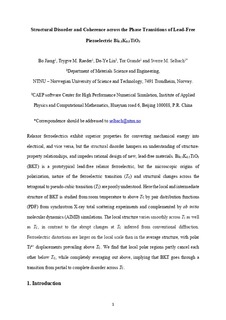| dc.contributor.author | Jiang, Bo | |
| dc.contributor.author | Ræder, Trygve Magnus | |
| dc.contributor.author | Lin, De-Ye | |
| dc.contributor.author | Grande, Tor | |
| dc.contributor.author | Selbach, Sverre Magnus | |
| dc.date.accessioned | 2019-04-12T08:34:41Z | |
| dc.date.available | 2019-04-12T08:34:41Z | |
| dc.date.created | 2018-08-27T21:57:52Z | |
| dc.date.issued | 2018 | |
| dc.identifier.citation | Chemistry of Materials. 2018, 30 (8), 2631-2640. | nb_NO |
| dc.identifier.issn | 0897-4756 | |
| dc.identifier.uri | http://hdl.handle.net/11250/2594416 | |
| dc.description.abstract | Relaxor ferroelectrics exhibit superior properties for converting mechanical energy into electrical energy, and vice versa, but the structural disorder hampers an understanding of structure–property relationships and impedes rational design of new, lead-free materials. Bi0.5K0.5TiO3 (BKT) is a prototypical lead-free relaxor ferroelectric, but the microscopic origins of polarization, nature of the ferroelectric transition (TC), and structural changes across the tetragonal to pseudocubic transition (T2) are poorly understood. Here the local and intermediate structure of BKT is studied from room temperature to above TC by pair distribution functions (PDFs) from synchrotron X-ray total scattering experiments and complemented by ab initio molecular dynamics (AIMD) simulations. The local structure varies smoothly across T2 as well as TC, in contrast to the abrupt changes at TC inferred from conventional diffraction. Ferroelectric distortions are larger on the local scale than in the average structure, with polar Ti4+ displacements prevailing above TC. We find that local polar regions partly cancel each other below TC, while completely averaging out above, implying that BKT goes through a transition from partial to complete disorder across TC. | nb_NO |
| dc.language.iso | eng | nb_NO |
| dc.publisher | American Chemical Society | nb_NO |
| dc.title | Structural Disorder and Coherence across the Phase Transitions of Lead-Free Piezoelectric Bi0.5K0.5TiO3 | nb_NO |
| dc.type | Journal article | nb_NO |
| dc.type | Peer reviewed | nb_NO |
| dc.description.version | acceptedVersion | nb_NO |
| dc.source.pagenumber | 2631-2640 | nb_NO |
| dc.source.volume | 30 | nb_NO |
| dc.source.journal | Chemistry of Materials | nb_NO |
| dc.source.issue | 8 | nb_NO |
| dc.identifier.doi | 10.1021/acs.chemmater.7b05278 | |
| dc.identifier.cristin | 1604789 | |
| dc.relation.project | Notur/NorStore: NN9264K | nb_NO |
| dc.relation.project | Norges forskningsråd: 228571 | nb_NO |
| dc.description.localcode | © American Chemical Society 2018. This is the authors accepted and refereed manuscript to the article. | nb_NO |
| cristin.unitcode | 194,66,35,0 | |
| cristin.unitname | Institutt for materialteknologi | |
| cristin.ispublished | true | |
| cristin.fulltext | postprint | |
| cristin.qualitycode | 2 | |

